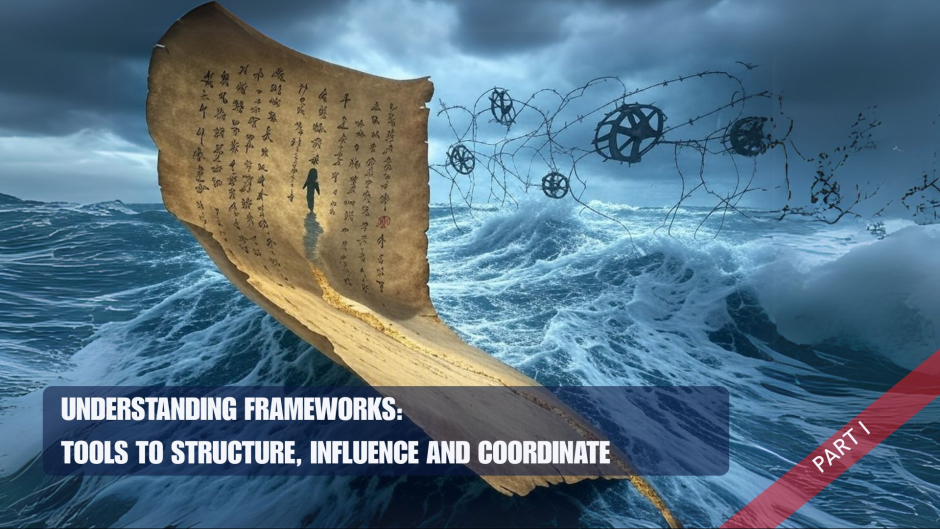Xavier Azalbert, France-Soir
Understanding Frameworks: Tools to Structure, Influence and Coordinate – part I
This article inaugurates a series that will dive into the heart of frameworks, the methodological frameworks that shape the way we think, act and interact in an increasingly complex world. In this first part, we explore the origins of frameworks, tracing their history from the military strategies of antiquity to modern digital tools, while examining their role in areas such as marketing, intelligence, education or cybersecurity. The following articles in this series will delve into complementary aspects: first, the tension between humans and the "normatization" or "norming" imposed by these frameworks, which standardize our behaviors at the risk of limiting our creativity; second, the modern uses of frameworks in information management, where systematic and probabilistic approaches are redefining decision-making; and finally, strategies to counter the sometimes invasive influence of these tools, in order to preserve our autonomy in the face of their structuring power. Through this series, we will decode how frameworks, both allies and challenges, shape our society and how we can take advantage of them while remaining in control of our choices.
In a world where information flows at lightning speed and human interactions are becoming more complex, frameworks, or methodological frameworks, have become essential tools for organizing, standardizing and influencing. Whether you're designing an advertising campaign, responding to customers in a call center, analyzing data in intelligence, running a business, countering a cyberattack, or structuring education, these frameworks simplify complex processes to achieve predictable results. But where do they come from? Were they born in strategic intelligence circles, in mathematical calculations such as Markov chains and Bayesian probabilities, or in the discoveries of the social and psychological sciences? This article traces the history of frameworks, explores their uses through concrete examples and sheds light on their origins, while remaining accessible to a neophyte.
What is a Framework?
Think of a methodological framework as a recipe: a series of clear steps, with precise ingredients, to get a tasty dish every time. A framework is a conceptual or methodological tool that organizes actions, analyses, or processes in a systematic way in order to achieve a goal. It can be used to standardize practices, persuade an audience, or coordinate complex efforts. In everyday life, we use frameworks without thinking about it: a meeting plan, a CV template or a method for organizing tasks are all small frameworks.
In professional contexts, these tools take various forms. In marketing, the AIDA model (Attention, Interest, Desire, Action) guides advertisers to transform a simple passer-by into a loyal customer. In call centers, standardized scripts ensure that every operator offers a consistent response, regardless of the customer. In intelligence, structured methods make it possible to analyze sensitive information or to carry out influence operations. In business management, McKinsey's General Survey Outline helps consultants diagnose an organization's strengths and weaknesses. In cybersecurity, the MITRE ATT&CK framework maps hacker tactics to better protect systems. In education, standardized school curricula organize learning for millions of students. All of these frameworks share a common goal: to make processes repeatable, efficient, and aligned with a common goal.
An ancient and evolving history
The history of frameworks is as old as civilization itself. These tools emerged at different times, shaped by disciplines like military strategy, social sciences, education, and, later, mathematics. Their evolution reflects the changing needs of societies, from ancient battlefields to modern data centers.
Origins in Antiquity
The first methodological frameworks appeared well before the modern era, in the spheres of military intelligence and influence. As early as the fifth century BC, the Chinese strategist Sun Tzu, in his work The Art of War, proposed principles for coordinating military campaigns. He advised, for example, to deceive the enemy or exploit his weaknesses, structuring operations into stages such as reconnaissance, attack and retreat. These ideas provide an informal, but already structured, framework for strategy and influence.

The Persian and Roman empires, on the other hand, used protocols to manage their vast networks of spies and couriers. The Persians, under Darius I, set up a system of royal roads with relays to quickly transmit information, an early form of logistical framework. The Romans organized networks of informants to monitor the provinces and anticipate revolts, with standardized methods for collecting and reporting data. These practices, although rudimentary, prefigure modern intelligence analysis frameworks.
At the same time, organized religions play a key role in influencing. The Catholic Church standardized its sermons and rituals to spread consistent messages across medieval Europe. These practices are reminiscent of modern propaganda campaigns, where a single message is designed to persuade the masses. In commerce, medieval guilds imposed contracts and learning rules, much like call center scripts standardize interactions today. At that time, frameworks relied on an intuitive understanding of human behavior, such as fear or loyalty, long before the birth of modern psychology.
The Nineteenth Century: Science Structures Influence and Education
With the rise of social sciences and industrialization in the nineteenth century, frameworks became more formal. Psychology and sociology are beginning to decode human behavior, providing scientific bases for persuading and organizing. In 1895, Gustave Le Bon published "The Psychology of Crowds", in which he explained how to influence the masses. His ideas inspired governments for their propaganda campaigns and advertisers for their first advertisements. In 1898, Elmo Lewis designed the AIDA model, which structured advertising campaigns in four stages: capture Attention, generate Interest, provoke Desire and call to Action. This model, still used in today's digital ads, illustrates how psychology becomes a tool for structured persuasion.
In intelligence, modern services, such as the Second French Bureau created in 1871, adopted systematic methods to collect and analyze information. These protocols, such as sorting sources or cross-referencing data, are the ancestors of current analysis frameworks. In other areas, marketing is taking over AIDA to standardize messages in the press and posters, much like religious sermons unified discourse. The first call centers, or rather their precursors in telephone switchboards, used rudimentary scripts inspired by mail order sales. In management, Frederick Taylor introduced scientific management in 1911, a framework for optimizing factories, which influenced standardized call center processes through his obsession with efficiency.
Education, on the other hand, is becoming a key area for frameworks, particularly in France with the reforms of Jules Ferry. From the laws of 1881 and 1882, education became compulsory, free and secular for all children aged 6 to 13. These reforms marked the birth of modern education by structuring teaching around standardized programs, organized into groups of subjects such as mathematics, literature, history and science. This methodological framework is based on a growing understanding of human development, influenced by the social sciences and early studies on child psychology. By standardizing education nationwide, Ferry's reforms enabled a massive diffusion of knowledge, increasing access to learning and laying the foundation for a more educated society. This system, while sometimes rigid, illustrates how educational frameworks standardize processes to coordinate teaching at scale, just as intelligence protocols organize analysis or call center scripts unify interactions. By making education accessible, these frameworks contribute to raising the general level of knowledge and cognitive skills of populations, although the impact on collective intelligence remains influenced by socio-economic and cultural factors. This approach leaves out elements related to intuition, the constraint of creativity or other cognitive abilities of human beings.

At this stage, the social sciences, with their focus on persuasion, and intelligence, with its methods of analysis, dominate the creation of frameworks. Mathematics, such as Markov chains, formalized by Andrey Markov in 1906, remained purely theoretical and did not yet have a concrete application, nor did nonlinear algebra.
The beginning of the twentieth century: marketing, propaganda and measurement of intelligence
The 1900s to 1930s marked an acceleration in the use of frameworks, driven by advances in psychology, the need for propaganda during the First World War and the rise of marketing. Edward Bernays, often considered the father of public relations, published "Propaganda" in 1928. Based on Freud's theories, he shows how to manipulate public opinion. His ideas structure advertising campaigns, such as those of the J. Walter Thompson agency, which uses creative briefs to harmonize messages broadcast in the press and on the radio.
During the First World War, governments relied on cadres to orchestrate propaganda. In the United States, the Committee on Public Information (CPI) disseminates messages to mobilize the population in support of the war effort. These methods, which structure influence on a large scale, directly inspire modern marketing. At the same time, the intelligence services are formalizing their espionage operations, with protocols to coordinate agents and analyze data.
In education, the frameworks established in the nineteenth century continue to evolve, but a new framework for measuring human abilities is emerging: the intelligence quotient (IQ). Developed by Alfred Binet at the beginning of the twentieth century, IQ aims to assess children's cognitive abilities in order to adapt teaching to their needs. This framework, formalized in 1905 with the Binet-Simon scale, became a key tool for standardizing the assessment of intelligence in schools. However, IQ focuses on academic performance, such as memory or logical reasoning, and neglects dimensions such as altruism or societal contribution. This limitation is underlined by contemporary thinkers, such as Didier Audebert, who proposes the concept of utility quotient (QU) in his book "Utility Quotient: Let's become more useful every day!". The QU measures the value of an individual by his or her positive impact on society, for example, through altruistic actions or community initiatives. This idea, mentioned in an article in France-Soir in 2023, criticizes education systems that favor IQ and direct non-compliant students to manual courses, forgetting their potential for social utility. The contrast between IQ and QU illustrates how educational frameworks, while effective in standardizing learning, can limit the recognition of certain forms of intelligence and thus miss key information.
In other industries, marketing relies on AIDA for iconic campaigns, such as those of Coca-Cola in the 1930s, which align their messages to appeal to a global audience. Telesales offices, the forerunners of call centers, adopted standardized scripts, inspired by mail order sales and Taylor's principles. In management, McKinsey & Company, founded in 1926, developed the General Survey Outline (GSO) in 1931, a systematic framework for analyzing companies, comparable to advertising briefs in its rigor. Methodological frameworks are spreading, but the social sciences and intelligence remain the main influences, with probabilities remaining confined to theory.
The Mid-Twentieth Century: Mathematics Enters the Scene
The 1940s and 1950s marked a turning point, with a convergence of the social sciences, intelligence and mathematics. Communication theories, such as the Shannon-Weaver model published in 1948, influence marketing and intelligence by structuring the transmission of messages. Call centers incorporate psychological techniques, such as active listening inspired by the work of Carl Rogers, to improve customer interactions.
In intelligence, the Second World War accelerated the formalization of cadres. Allied services, such as the OSS (precursor to the CIA) or MI6, developed methods to analyse the data, particularly at Bletchley Park, where the deciphering of Nazi codes was based on structured processes. Disinformation operations, such as Operation Mincemeat, which deceives the Germans about invasion plans, rely on cadres to coordinate efforts. These methods foreshadow modern tools such as DISARM, which maps disinformation campaigns. Or information, it all depends on which side of the fence you are on!

XXXXXXXXXXXXX
Mathematics are starting to play a more important role. Markov chains, applied in game theory by John von Neumann in 1944, influence military and industrial frameworks, especially in systems analysis. However, their impact remains limited in marketing or call centers. In other industries, ad agencies like BBDO use multi-channel frameworks to align their campaigns, much like disinformation plans align narratives. Telephone switchboards, such as those of AT&T, adopt standardized operating manuals. In management, McKinsey laid the foundations for frameworks such as the 7S Framework, which would see the light of day in the 1970s. In cybersecurity, the first forms of security frameworks, based on cryptography, are based on mathematical analyses.
From the end of the twentieth century to the present: an era of convergence
Since the 1960s, frameworks have diversified and modernized, integrating social sciences, intelligence, and mathematics. In marketing, models such as McKinsey's Value Delivery System or Consumer Decision Journey, developed in the 1980s, structure customer interactions in the age of data. Call centers are adopting customer relationship management (CRM) systems to standardize responses, based on behavioral analytics.
In intelligence, agencies like the CIA or the KGB formalize frameworks for psychological operations (PSYOPS), influencing tools like DISARM, which analyzes online information/disinformation campaigns. Markov chains and Bayesian or conditional probabilities, now widely used in computer science, make it possible to model complex behaviors, such as search algorithms or the detection of cybersecurity anomalies. The MITRE ATT&CK framework, launched in 2013, uses probabilistic models to map cyberattack tactics, becoming a global benchmark.

In other areas, marketing uses data to segment audiences, just as intelligence segments its targets. Call centers rely on CRMs to align interactions, much like intelligence analytics frameworks align data. In management, McKinsey formalizes tools such as the GE-McKinsey Matrix and the 7S Framework, inspired by systemic approaches. In cybersecurity, ATT&CK structures defenses against threats such as those of the Lazarus group, known for its attacks on financial institutions.
Similar uses of frameworks across sectors
Frameworks have evolved in parallel in different sectors, but their objectives remain constant : to standardize practices, influence behaviors and coordinate efforts. In marketing, the AIDA model and creative briefs of the 1920s standardize advertising messages, just as call center scripts align operators' responses. In intelligence, nineteenth-century espionage protocols and twentieth-century disinformation frameworks structure operations, just as MITRE ATT&CK organizes cyber threat analysis. In management, McKinsey's 7S Framework guides business transformations, much like military plans orchestrate campaigns. In education, Ferry's standardized programs coordinate instruction for generations of students.

To influence, marketing relies on the principles of Bernays and AIDA, which exploit psychology to persuade, just as the psychological operations of intelligence manipulate perceptions. Call center scripts use techniques like urgency or empathy, similar to propaganda campaigns. In cybersecurity, DISARM maps online influencer campaigns, a process comparable to designing an advertising brief. In education, pedagogical frameworks seek to shape minds, although tools like IQ may limit the recognition of certain forms of intelligence.
In terms of coordination, the multi-channel marketing campaigns of the 1930s aligned the media, just as intelligence plans synchronized agents. Telephone switchboards centralize interactions, just as management executives centralize decisions. In intelligence, spy networks rely on protocols, just as ATT&CK coordinates cybersecurity defenses. In management, the 7S Framework aligns teams, much like scripts unify operators.
Where do the frameworks come from?
To identify the main source of frameworks, three influences stand out: intelligence services, mathematics, and social sciences.
The intelligence services have an old claim. Sun Tzu's strategic frameworks, Persian and Roman spy networks, and modern nineteenth-century methods show that intelligence has always structured analysis and influence. World War I propaganda, orchestrated by executives like the Committee on Public Information, directly inspired marketing via figures like Bernays. Modern tools like DISARM and ATT&CK build on this tradition. However, these frameworks were often informal and limited to the military context until the twentieth century.
Markov chains, formalized in 1906, have a more recent influence and later Bayesian probabilities, chaos theory, catastrophe theory or anything that is non-linear. They shaped the systemic frameworks of the twentieth century, particularly in computer science and cybersecurity, where ATT&CK uses probabilistic models to analyze attacks. They have also impacted management (process analysis) and marketing (customer journey). But their practical application did not emerge until the middle of the twentieth century, well after the first frameworks of influence.
The social and psychological sciences offer another perspective. As early as the nineteenth century, thinkers such as Gustave Le Bon formalized the influence of the masses, inspiring propaganda, marketing, and education. The AIDA model, Bernays' campaigns, and Ferry's reforms rely on psychology to persuade or structure learning, influencing call centers, management, and intelligence. However, these frameworks required the understanding and codification of modern psychology to become systematic.
In conclusion, frameworks were mainly born from intelligence services, with their ancient strategic frameworks, and from the social sciences, which formalized influence and education in the nineteenth century. Intelligence structures analysis and coordination, while the social sciences dominate persuasion and learning. Mathematics, although crucial for modern executives, did not come into play until the twentieth century, with the rise of data and computer science.
Why do frameworks matter today
In our digital age, frameworks are indispensable. In marketing, campaigns such as those of Nike or Apple rely on AIDA to captivate millions of consumers. In call centers, CRMs can manage thousands of interactions consistently. In cybersecurity, MITRE ATT&CK helps counter threats such as those of the Lazarus Group. In management, the 7S Framework aligns global teams to solve complex challenges. In education, standardized curricula continue to train generations, although debates over tools such as IQ and Q underscore the need to rethink their scope.
But, frameworks aren't just for experts. Every time you plan a project, follow a recipe, or write a structured email, you're using a methodological framework. These tools simplify complexity, making the world more understandable and manageable.
Endless evolution
From Sun Tzu's strategies to digital tools like MITRE ATT&CK, frameworks have come a long way. In antiquity, they emerged in intelligence and religion. In the nineteenth century, the social sciences, education, and intelligence formalized them. At the beginning of the twentieth century, marketing, call centers and measures such as IQ seized on it, influenced by propaganda. From the 1940s onwards, mathematics, along with Markov chains, enriched executives in intelligence, management, and cybersecurity. Today, frameworks integrate psychology, strategy, and data to structure our world. In the next chapters, we will also see their modern uses in information around the management of the covid crisis or the Russian-Ukrainian conflict or even the demonization, the invisibilization of people who do not rally to the consensus, a group truth that does not matter if it comes close to the truth as long as it is accepted as consensus, thus polluting the information, and biasing decisions.
Their success lies in their universality. Whether it's convincing a customer, analyzing a threat, coordinating a team, or training a student, frameworks offer a compass for navigating complexity.
Understanding their history and their uses means better understanding the workings of a society where order, influence and learning are more necessary than ever. But you also have to know how to defend yourself against it.
